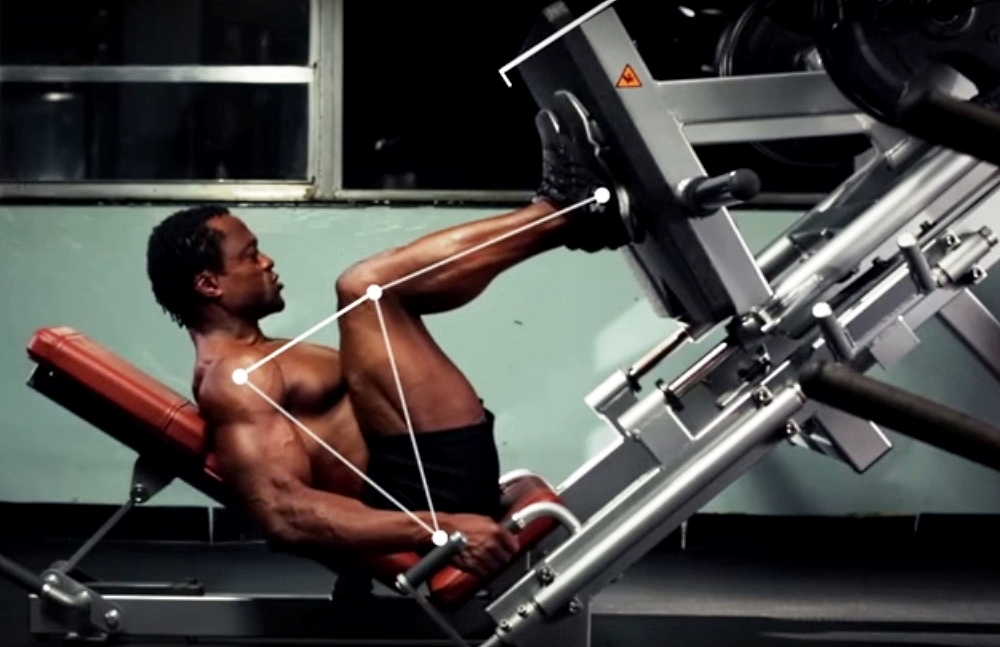For bodybuilders, the leg press is perhaps the best machine exercise. Performing the leg press is much easier than the squat. Yet we often see leg pressers make mistakes, in particular on the points below.
1. POSITIONING THE FEET INCORRECTLY
The key question with the leg press: where exactly do I put my feet? How wide and how high?
Well, the best position of your feet is personal. It depends on how big your upper and lower legs are. But to give some guidelines: put your feet about shoulder-width apart on the plate. Almost right next to each other, pointing out a little bit. Just like with the squat. Certainly not pointing inward, because that will also make your knees point inward. As the weight comes toward you, knees should point straight toward your shoulders.
In any case, place your feet far enough apart that your knees in the bottom position can slide along your stomach to achieve an optimal range of motion (see mistake 2).
Vertically, place your feet approximately in the center of the plate. You can also go higher, but then you shift the muscle tension to your buttocks and hamstrings instead of the target muscle, the quadriceps. In addition, you risk a bulging lower back.
Placing the feet very low isn’t ideal either, because that puts too much pressure on your knee joints. In addition, you make it more difficult to press from your heels (see mistake 4). Make sure that your knees in the lower position do not extend above your toes.
2. TOO SMALL OR TOO LARGE ROM
The leg press can be a nice ego booster, especially for beginners. The learning curve is low and you can quickly push off a relatively large amount of weight. 1RMs twice the body weight are not uncommon. However, that is often only apparent.
Especially beginners are often guilty of a too small range of motion (ROM), even partial and quarter reps. That way you can indeed ‘press’ a lot of weight, but without your quads and other muscles being challenged in the least. Not infrequently, those mini-repetitions are also performed extra fast:
 The fast leg press: good for hours of occupational therapy.
The fast leg press: good for hours of occupational therapy.The correct ROM is the one where your upper and lower legs are at an angle of about 90 degrees. If you go back even further with your thighs, your hips come off the seat and you transfer the tension to your lower back. That is undesirable. As soon as you feel less tension on your quadriceps, your ROM will become too large. Basically, lower the weight to that 90-degree angle, but make sure you keep your buttocks firmly on the seat at all times.

If your gym has a wired seated leg press machine (instead of a plate loaded machine), you’ll need to pre-set the ROM by moving the seat position. Which position is best for you is a matter of experimentation.
3. LOCKING THE KNEES TOO ‘ROUGHLY’
Food for discussion: can the knees be locked at the end of a repetition with the leg press, so with straight legs? Opponents think that this puts too much tension on the knee joint. In addition, the lock on the knees would be at the expense of the tension on the trained muscle.
However, the latter is not a valid argument: training with constant tension, ie no rest between reps, may or may not be a conscious choice, which in principle is not inferior to training without constant muscle tension. Constant tension certainly gives a good stimulus, but you can use less weight. Without constant tension, the reps are less heavy and you can use more weight. The end result seems to be the same for muscle growth.
The argument that a lockout may be bad for the knees is also questionable, especially when you consider that in the ‘mirror’ exercise of the leg press, the barbel squat, you do fully extend your legs at the end of the rep. According to coach Mike Israetel, it is therefore okay to lock the knees at the end of a leg press repetition, as long as you do it carefully and not with brute force, as follows:
Instead, at the end of the rep, slow down a bit to lock your knees in a controlled manner:
4. PRESS FROM THE TOES
You sometimes hear that the leg press is bad for your knees. But that’s only true if you perform the exercise incorrectly, with incorrect foot positioning (mistake 1) and/or an overly aggressive lockout (mistake 3).
A third mistake that can put undue strain on your knee joints is pressing from your toes. Leg presses are done from the heels. This protects your knees, while you put your quadriceps under optimal tension. This is mainly a matter of mental focus. In addition, you should make sure that your feet are not too low on the plate (see mistake 1).
5. USING TOO MUCH OR TOO LITTLE WEIGHT
The leg press is such an exercise that allows you to go ‘nice and heavy’, but don’t overdo it. Don’t make it a survival journey where you try to move the weight with all your strength; the quadriceps are your target muscle and should therefore be the limiting factor in your set. That also means that you should not go too low in weight, so train in a very high rep range, because then there is a good chance that cardiovascular fatigue will become your limiting factor.
Ideally, you should therefore do your leg presses in the range of 10 to 20 repetitions, of course close to muscle failure.